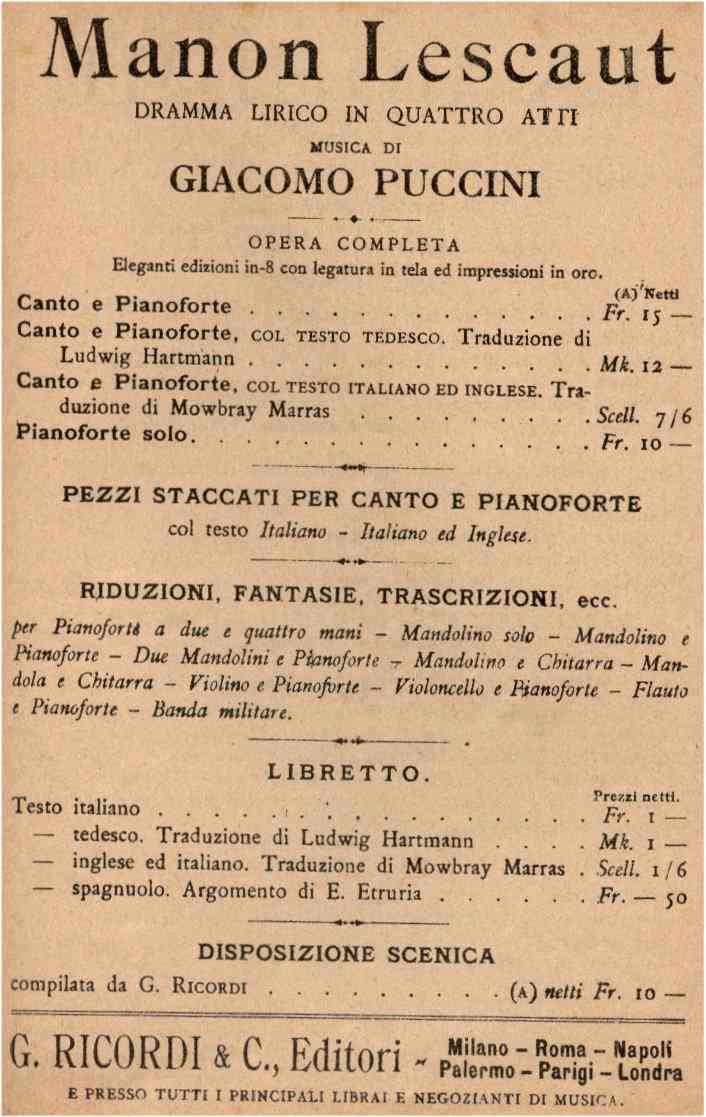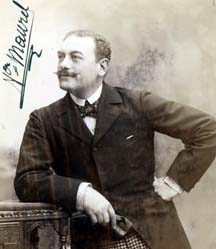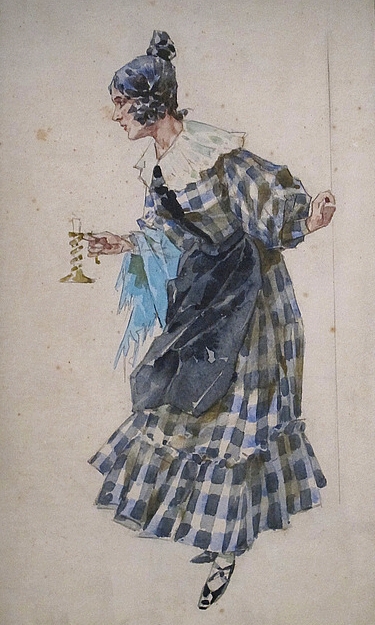|
Giulio Crimi
Giulio Crimi (May 10, 1885 – October 29, 1939) was an Italian operatic tenor. Biography Crimi was born in Paternò, kingdom of Italy, Italy. He studied in Catania with Adernò and made his debut in Palermo, as Manrico in ''Il trovatore'', in 1910, later appearing in Treviso as Hagenbach in ''La Wally''. He sang throughout Italy, Rome, Milan, etc., and created in Turin the role of Paolo in Zandonai's ''Francesca da Rimini (Zandonai), Francesca da Rimini'' in 1914. That same year saw his debut in London, where he sang the role of Avito in the local premiere of ''L'amore dei tre re'', at the Royal Opera House. In 1916, he made his debut at the Teatro Colón in Buenos Aires, and at the Lyric Opera of Chicago. His Metropolitan Opera debut took place in November 1918, as Radames in ''Aida'', the following month (on December 14) he created the roles of Luigi and Rinuccio in the Puccini operas ''Il tabarro'' and ''Gianni Schicchi''. He remained at the Met until 1922, singing La b ... [...More Info...] [...Related Items...] OR: [Wikipedia] [Google] [Baidu] |
Giulio Crimi In 1918
Giulio () is an Italian given name. Notable people with the name include: * Giulio Alberoni (1664–1752), Italian cardinal and statesman * Giulio Alenio (1582–1649), Italian Jesuit missionary and scholar * Giulio Alfieri (1924–2002), Italian automobile engineer * Giulio Andreotti (1919–2013), Italian politician * Giulio Carlo Argan (1909–1992), Italian politician and art historian * Giulio Base (born 1964), Italian film director * Giulio Berruti (born 1984), Italian film and television actor * Giulio Bizzozero (1846–1901), Italian physician * Giulio Bosetti (1930–2009), Italian actor and director * Giulio Brogi (1935–2019), Italian actor * Giulio Caccini ( 1545–1618), Florentine composer, significant innovator of the early Baroque era * Giulio Calì (1895–1967), Italian actor * Giulio Camillo ( 1480–1544), Italian philosopher * Giulio Campagnola ( 1482–1515), Italian painter * Giulio Campi (1500–1572), Italian painter and architect * Giulio Cappelli (1911–1 ... [...More Info...] [...Related Items...] OR: [Wikipedia] [Google] [Baidu] |
Metropolitan Opera
The Metropolitan Opera (commonly known as the Met) is an American opera company based in New York City, resident at the Metropolitan Opera House at Lincoln Center, currently situated on the Upper West Side of Manhattan. The company is operated by the non-profit Metropolitan Opera Association, with Peter Gelb as general manager. As of 2018, the company's current music director is Yannick Nézet-Séguin. The Met was founded in 1883 as an alternative to the previously established Academy of Music opera house, and debuted the same year in a new building on 39th and Broadway (now known as the "Old Met"). It moved to the new Lincoln Center location in 1966. The Metropolitan Opera is the largest classical music organization in North America. Until 2019, it presented about 27 different operas each year from late September through May. The operas are presented in a rotating repertory schedule, with up to seven performances of four different works staged each week. Performances are ... [...More Info...] [...Related Items...] OR: [Wikipedia] [Google] [Baidu] |
Loreley
The Lorelei ( ; ), spelled Loreley in German, is a , steep slate rock on the right bank of the River Rhine in the Rhine Gorge (or Middle Rhine) at Sankt Goarshausen in Germany, part of the Upper Middle Rhine Valley UNESCO World Heritage Site. The 1930s Loreley Amphitheatre is on top of the rock. Etymology The name comes from the old German words , Rhine dialect for "murmuring", and the Celtic term "rock". The translation of the name would therefore be "murmur rock" or "murmuring rock". The heavy currents, and a small waterfall in the area (still visible in the early 19th century) created a murmuring sound, and this combined with the special echo the rock produces to act as a sort of amplifier, giving the rock its name. The murmuring is hard to hear today owing to the urbanization of the area. Other theories attribute the name to the many boating accidents on the rock, by combining the German verb ('to lurk, lie in wait') with the same "ley" ending, with the translation "l ... [...More Info...] [...Related Items...] OR: [Wikipedia] [Google] [Baidu] |
La Forza Del Destino
' (; ''The Power of Fate'', often translated ''The Force of Destiny'') is an Italian opera by Giuseppe Verdi. The libretto was written by Francesco Maria Piave based on a Spanish drama, ' (1835), by Ángel de Saavedra, 3rd Duke of Rivas, with a scene adapted from Friedrich Schiller's '' Wallensteins Lager'' (''Wallenstein's Camp''). It was first performed in the Bolshoi Kamenny Theatre of Saint Petersburg, Russia, on 29 November 1862 O.S. (N.S. 10 November). ' is frequently performed, and there have been a number of complete recordings. In addition, the overture (to the revised version of the opera) is part of the standard repertoire for orchestras, often played as the opening piece at concerts. Performance history Revisions After its premiere in Russia, ''La forza'' underwent some revisions and made its debut abroad with performances in Rome in 1863 under the title ''Don Alvaro''. Performances followed in Madrid (with the Duke of Rivas, the play's author, in attend ... [...More Info...] [...Related Items...] OR: [Wikipedia] [Google] [Baidu] |
Manon Lescaut (Puccini)
''Manon Lescaut'' () is an Italian-language opera in four acts composed by Giacomo Puccini between 1889 and 1892 to a libretto by Luigi Illica, Marco Praga and , based on the 1731 novel '' Histoire du Chevalier des Grieux, et de Manon Lescaut'' by the Abbé Prévost. The opera was first performed in 1893 in Turin, at the Teatro Regio. Composition history The libretto is in Italian, and was cobbled together by five librettists whom Puccini employed: Ruggero Leoncavallo, Marco Praga, Giuseppe Giacosa, and Luigi Illica. The publisher, Giulio Ricordi, and the composer himself also contributed to the libretto. So confused was the authorship of the libretto that no one was credited on the title page of the original score. However, it was Illica and Giacosa who completed the libretto and went on to contribute the libretti to Puccini's next three – and most successful – works, ''La Bohème'', ''Tosca'' and ''Madama Butterfly''. Puccini took some musical elements in ''Manon Lesca ... [...More Info...] [...Related Items...] OR: [Wikipedia] [Google] [Baidu] |
Zazà
''Zazà'' is an opera by Ruggero Leoncavallo, with a libretto by the composer. The story concerns the French music hall singer, Zazà, and her affair and subsequent decision to leave her lover, Milio, when she discovers that he is married. The music is influenced by the French music halls where Leoncavallo had spent his early years as a composer. Its premiere was at the Teatro Lirico (Milan), Teatro Lirico in Milan on 10 November 1900, starring Rosina Storchio as Zazà, Edoardo Garbin as Milio, Mario Sammarco as Cascart and Clorinda Pini-Corsi as Anaide, and conducted by Arturo Toscanini. It was later seen in opera houses around the world. Over the following twenty years it received over fifty new productions from Palermo to Paris, Buenos Aires to Moscow, Cairo to San Francisco, arriving at the Metropolitan Opera on 16 January 1920 in a production directed by David Belasco and conducted by Roberto Moranzoni, starring Geraldine Farrar, Giulio Crimi and Pasquale Amato, and later, G ... [...More Info...] [...Related Items...] OR: [Wikipedia] [Google] [Baidu] |
Andrea Chénier
''Andrea Chénier'' () is a verismo opera in four acts by Umberto Giordano, set to an Italian libretto by Luigi Illica, and first performed on 28 March 1896 at La Scala, Milan. The story is based loosely on the life of the French poet André Chénier (1762–1794), who was executed during the French Revolution. The character Carlo Gérard is partly based on Jean-Lambert Tallien, a leading figure in the Revolution. It remains popular with audiences, though less frequently performed than in the first half of the 20th century. One reason for its survival in the repertoire is the lyrical-dramatic music provided by Giordano for the tenor lead, which gives a talented singer opportunities to demonstrate his skills and flaunt his voice. Giuseppe Borgatti's triumph in the title role at the first performance immediately propelled him to the front rank of Italian opera singers. He went on to become Italy's greatest Wagnerian tenor, rather than a verismo-opera specialist. Performance ... [...More Info...] [...Related Items...] OR: [Wikipedia] [Google] [Baidu] |
Pagliacci
''Pagliacci'' (; literal translation, "Clowns") is an Italian opera in a prologue and two acts, with music and libretto by Ruggero Leoncavallo. The opera tells the tale of Canio, actor and leader of a commedia dell'arte theatrical company, who murders his wife Nedda and her lover Silvio on stage during a performance. ''Pagliacci'' premiered at the Teatro Dal Verme in Milan on 21 May 1892, conducted by Arturo Toscanini, with Adelina Stehle as Nedda, Fiorello Giraud as Canio, Victor Maurel as Tonio, and Mario Ancona as Silvio. Soon after its Italian premiere, the opera played in London (with Nellie Melba as Nedda) and in New York (on 15 June 1893, with Agostino Montegriffo as Canio). ''Pagliacci'' is the composer's only opera that is still widely performed. ''Pagliacci'' is often staged with ''Cavalleria rusticana'' by Pietro Mascagni, a double bill known colloquially as "Cav and Pag". Origin and disputes Leoncavallo was a little-known composer when Pietro Mascagni's ''Cavalleria ... [...More Info...] [...Related Items...] OR: [Wikipedia] [Google] [Baidu] |
Cavalleria Rusticana
''Cavalleria rusticana'' (; Italian for "rustic chivalry") is an opera in one act by Pietro Mascagni to an Italian libretto by Giovanni Targioni-Tozzetti and Guido Menasci, adapted from an 1880 short story of the same name and subsequent play by Giovanni Verga. Considered one of the classic ''verismo'' operas, it premiered on 17 May 1890 at the Teatro Costanzi in Rome. Since 1893, it has often been performed in a so-called ''Cav/Pag'' double-bill with ''Pagliacci'' by Ruggero Leoncavallo. Composition history In July 1888 the Milanese music publisher Edoardo Sonzogno announced a competition open to all young Italian composers who had not yet had an opera performed on stage. They were invited to submit a one-act opera which would be judged by a jury of five prominent Italian critics and composers. The best three would be staged in Rome at Sonzogno's expense. Mascagni heard about the competition only two months before the closing date and asked his friend Giovanni Targioni-Tozze ... [...More Info...] [...Related Items...] OR: [Wikipedia] [Google] [Baidu] |
La Traviata
''La traviata'' (; ''The Fallen Woman'') is an opera in three acts by Giuseppe Verdi set to an Italian libretto by Francesco Maria Piave. It is based on ''La Dame aux camélias'' (1852), a play by Alexandre Dumas ''fils'' adapted from his own 1848 novel. The opera was originally titled ''Violetta'', after the main character. It was first performed on 6 March 1853 at La Fenice opera house in Venice. Piave and Verdi wanted to follow Dumas in giving the opera a contemporary setting, but the authorities at La Fenice insisted that it be set in the past, "c. 1700". It was not until the 1880s that the composer's and librettist's original wishes were carried out and " realistic" productions were staged. ''La traviata'' has become immensely popular and is among the most frequently performed of all operas. Composition history For Verdi, the years 1851 to 1853 were filled with operatic activity. First, he had agreed with the librettist Salvadore Cammarano on a subject for what would ... [...More Info...] [...Related Items...] OR: [Wikipedia] [Google] [Baidu] |
La Bohème
''La bohème'' (; ) is an opera in four acts,Puccini called the divisions ''quadri'', ''tableaux'' or "images", rather than ''atti'' (acts). composed by Giacomo Puccini between 1893 and 1895 to an Italian libretto by Luigi Illica and Giuseppe Giacosa, based on ''Scènes de la vie de bohème'' (1851) by Henri Murger. The story is set in Paris around 1830 and shows the Bohemian lifestyle (known in French as "") of a poor seamstress and her artist friends. The world premiere of ''La bohème'' was in Turin on 1 February 1896 at the Teatro Regio, conducted by the 28-year-old Arturo Toscanini. Since then, ''La bohème'' has become part of the standard Italian opera repertory and is one of the most frequently performed operas worldwide. In 1946, fifty years after the opera's premiere, Toscanini conducted a commemorative performance of it on radio with the NBC Symphony Orchestra. A recording of the performance was later released by RCA Victor on vinyl record, tape and compact disc. ... [...More Info...] [...Related Items...] OR: [Wikipedia] [Google] [Baidu] |
Gianni Schicchi
() is a comic opera in one act by Giacomo Puccini to an Italian libretto by Giovacchino Forzano, composed in 1917–18. The libretto is based on an incident mentioned in Dante's ''Divine Comedy''. The work is the third and final part of Puccini's (The Triptych)three one-act operas with contrasting themes, originally written to be presented together. Although it continues to be performed with one or both of the other operas, is now more frequently staged either alone or with short operas by other composers. The aria is one of Puccini's best known, and one of the most popular arias in opera. Puccini had long considered writing a set of one-act operas which would be performed together in a single evening, but faced with a lack of suitable subjects and opposition from his publisher, he repeatedly put the project aside. However, by 1916 Puccini had completed the one-act tragedy and, after considering various ideas, he began work the following year on the solemn, religious, all- ... [...More Info...] [...Related Items...] OR: [Wikipedia] [Google] [Baidu] |










